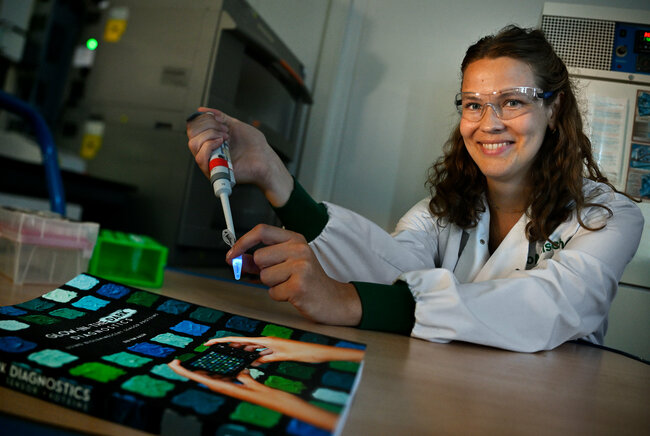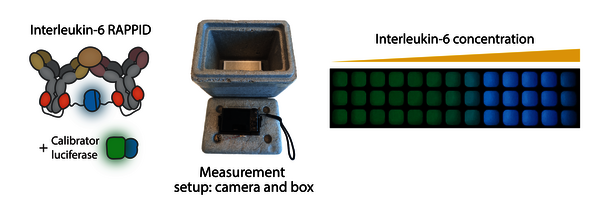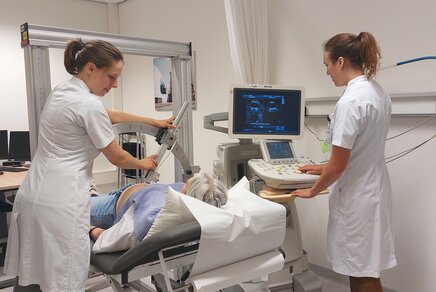Glow-in-the-dark at the general practitioner
Eva van Aalen defended her PhD thesis at the Department of Biomedical Engineering on September 15th.

TU/e researcher Eva van Aalen has developed a glow-in-the-dark test that can make disease diagnosis by general practitioners or in hospitals faster. This test could potentially also be used by patients at home, for example to monitor the concentration of certain drugs in the body. Van Aalen will defend her PhD thesis at the department of Biomedical Engineering on Friday, September the 15th.
Biomedical engineer Eva van Aalen is standing in a dark lab holding a pipette above a tube. Just seconds later the tube turns into a luminescent green color, while a second tube radiates a bright blue color. The video Van Aalen once made to demonstrate how her luminescent molecules work, makes it seem like a magic trick.
Even though large quantities of bioluminescent sensor proteins can be seen with the naked eye, in an experimental setting it takes a sensitive camera to detect them, and her research entails more than a glow-in-the dark show, Van Aalen stresses with a smile.
Clinical laboratories often use immunoassays for disease diagnosis, tests during which antibodies bind to a specific molecule of interest. However, these tests, which are usually automated, are relatively time consuming, due to the many incubation and washing steps.
Moreover, the high number of liquids and plastics makes them anything but sustainable. That is why for some time now, TU/e professor Maarten Merkx’s research group has been focusing on the development of bioluminescent sensor tests that need to enable faster diagnostic testing, Van Aalen explains.
“These tests are a matter of ‘mix and read,’ which leads to a much faster test result. We use specific proteins for this purpose, luciferases. In nature, this group of enzymes is known from fireflies, glowworms and algae that can produce light as a result of a chemical reaction: bioluminescence.”
Molecular traffic light
The various senor platforms described by Van Aalen in her thesis are based on a small, luminescent enzyme that derives from a deep-sea shrimp, NanoLuc luciferase. In order to make the senor more stable and sensitive, she fused the blue NanoLuc with a second, green luminescent protein.
“Instead of a blue, fading light, we’ve now built a highly stable molecular traffic light. This allows us to measure the presence of certain molecules in a sample with a high level of sensitivity. If we detect green, we know that the molecule isn’t present, the bluer it becomes, the greater the presence of the molecule.” She takes out her thesis and shows the cover: several blocks in various shades of blue and green.

Van Aalen has demonstrated that this technology makes it possible to detect several different molecules, and she made adjustments to the platform to allow for the most optimal measurement in every possible situation.
Together with biotech company Genmab, she took the first successful steps towards a tumor marker test that looks for cancer growth in blood samples and she hopes that the biosensor will one day be used to make cancer cells visible during oncological procedures.
Other targets, such as zinc – which poses a challenge, since this is a very small molecule –, certain drugs, and viral and bacterial RNA and DNA can also be measured rapidly in patient samples. “During the COVID-19 pandemic, we were one of the few groups that was allowed to continue to work during the lockdown.
We worked day and night to develop an antigen test for SARS-CoV-2. Later, fellow PhD student Harm van der Veer and I worked on the development of a new sensor platform that can detect viral or bacterial SARS-CoV-2 RNA, which we eventually were successful at in collaboration with the Rijnstate Hospital. It definitely gave research efforts into the use of bioluminescent biosensors a boost.”
Reading device
However, a large-scale rollout, for so-called Point of care applications (measurements carried out close to the patient) at a general practitioner or at home, requires one essential component that’s still missing: a convenient and simple device that reads out test results.
Since Van Aalen’s project is part of the RAAK-PRO program, an applied research collaboration between Fontys and TU/e scientists, she didn’t just work on the sensor technology, but also on the development of such a reading device.

“The majority of experiments were carried out with a test setup in a polystyrene container with a camera above it. When that turned out to be successful after many adjustments at a chemical level, we took it a step further. A good system consists of a sensor, a disposable chip, and a device that can read the bioluminescent signal.
Together with Professor Jaap den Toonder’s microfluids research group and researchers from Fontys, we set out to design a working reading device and a microfluid disposable chip. A new PhD student will continue with this work and a general practitioner will join the follow-up project.”
Because if it were up to Van Aalen – who will continue with her work on bioluminescent sensors at TU/e spinoff Lumabs – glow-in-the-dark tests will become a common feature of clinical diagnostics within the near future. “A well-developed platform technology will make it relatively easy to make assays for other biomarkers."
"Fast, sensitive tests are in high demand. For a more efficient disease diagnosis, but also to reduce pressure on clinical laboratories. My father asked me so many times over the past years how long it would take before ‘my’ rapid test finally ends up on the desk at his general medical practice.”
More on Health



Latest news


